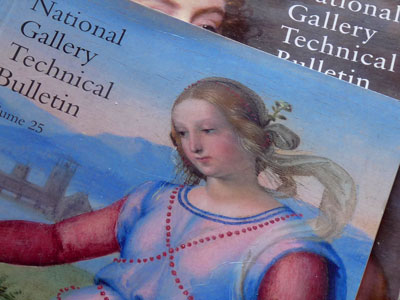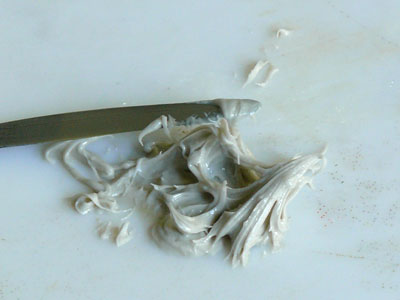
After about five years of research into older painting materials, I had developed a way of making thixotropic paint reliably. But this sense of accomplishment, perhaps even complacency, proved to be short-lived. In the winter of 2007 I read the new edition of Rembrandt: Art in the Making, a collaboration by the National Gallery (London) technical staff. This book contained the results of research into the composition of Rembrandt's paint using sophisticated methods such as mass spectroscopy and FTIR microscopy, techniques which analyze minute paint samples at the molecular level. The conclusion was that, in the paintings tested, Rembrandt managed to do everything he did with linseed oil, pigment, and chalk.
At first, wedded to my handmade, hard resin varnish method and its probable medieval origins, this seemed preposterous. Chalk? Oh, how droll! What about Eastlake's conclusion, what about De Mayerne's interest in amber in his well-known 17th century manuscript? From a perspective distorted by years within the lost secrets alembic, it seemed the technique couldn't be based on anything this simple. How annoying those scholarly technicians suddenly became, with their high powered microscopes and recondite terminology. But, after a few weeks of fulminating, a more moderate voice surfaced. Real research didn't dismiss anything as ridiculous without a significant amount of evidence one way or the other. Sure, it was silly, but it couldn't hurt to try it.
And so, the next morning -- skeptically, expecting the worst -- I mixed some marble dust with a slightly preheated oil using a palette knife.
This simple act produced a complex moment. It was instantly clear from the rheology of the resulting material that my precious hard resin theory had just been demolished. This was both humbling and not a little humiliating. At the same time, the obvious potential of this simple putty meant that, after five years, I was finally on my way out of the labyrinth. This was a source of great relief. In spite of myself, I had stumbled on the missing piece: a medium that was inherently thixotropic, but based on the oil alone.
While I had read about various calcium carbonates, as well as ground silica and glass, being used in older painting, and had in fact used them as useful adjuncts, I'd never bothered to explore this direction purely on its own. It had seemed too simple or "inert" on the one hand, too unaesthetic, or technically unromantic, on the other. So, in the long run, the fundamental culprit inhibiting progress turned out to be a preconceived prejudice with no experiential basis whatsoever: mine.
This development meant a shift in emphasis with the materials. I now began exploring ways the oil could be modified in use with various stone dusts to produce mediums with complex rheologies. This again took time, and only crystallized when the oil was addressed at the most basic level: how it was originally refined for use in painting. But for the first time, the research was focused, and a logic presented itself concerning the craft based on a cumulative depth of materials awareness, rather than on a specific arcane method or ingredient. Once apparent, this seemed painfully obvious, the penultimate "duh" moment. The search for the special missing ingredient itself was the snipe hunt, the craft was in fact about what occurred through paying closer attention to the basics, effectively turning them into something new. Not only did this make sense in terms of inspired simplicity of means, it provided the most effective protection for the method because its actual secrets were hidden in plain sight. Thinking back on my own relative technical nescience before the project began, even after having painted for 15 years with a focus on what I believed was the craft, I realized once again that experience with the materials had many levels, and that yet another one was beginning. The root of the system was the oil: how it was processed, and how it was then modified by traditional factors such as heat, sunlight, and time.

The craft of hand-refined linseed oil and the putty medium that has been developing since 2007 would have been unfathomable when I began painting, or even after a decade. For me at least, the haptic intelligence involved had to be acquired slowly. The basic ingredients themselves are simple: painter refined oil, pigment, various types of calcium carbonate or silica, a small amount of starch gel, or egg in some cases. But the subsequent manipulations, especially of the oil, are well beyond anything I found written down. Chalk or silica are also not mentioned in any of the older texts, and yet have proven to be in many older paintings. These humble, "inert" additions in fact change the craft profoundly.
It took many years of experiments to realize that, to produce complex results reliably, the foundational elements of the craft must be simple. And many paintings produced in the 17th century are complex to the point of being virtually unfathomable. But because painting for one's livelihood was essentially competitive, the deeper aspects of the craft, the manipulations of the basic elements, were rarely shared, often not even with apprentices or students. Once it became clear that something important had been lost from older practice -- a process that begins in the 18th, but becomes focal in the 19th century -- a de facto assumption of hidden complexity has been the recurring hallmark of the search for older methods. From the assortment of Reynold's materials in his attempts to emulate Rembrandt, to the technical minefield of 19th century meglip variations documented so well by Dr. Leslie Carlyle in The Artist's Assistant (2001), to the specious system of Maroger in Secret Formulas and Techniques of the Masters (1948), the quest has been for the secret ingredient that then enables the fabled trick of miraculous painting. However, thanks to the recent research of technical art history, we now know that the secrets of oil painting were much more probably about how well-known ingredients were processed and then combined. How did our ideas about older painting technique go so far astray?